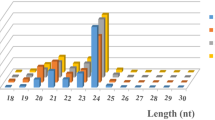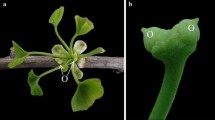Abstract
The root-knot nematode Meloidogyne incognita is among the most damaging plant-parasitic pests of several crops including cotton (Gossypium hirsutum) and tomato (Lycopersicon escultentum). Recently, a genome has become available for M. incognita, which greatly facilitates investigation of the interactions between M. incognita and its plant hosts at the molecular level and enables formation of hypotheses concerning development at the cellular level. MicroRNAs (miRNAs) are a class of small RNA molecules that serve as endogenous gene regulators. They regulate many biological processes including reproduction, the sequencing of morphological development, and potentially of parasitism as well. Certain miRNAs regulate fundamental metabolism pathways and stress responses in M. incognita. Since a list of miRNAs has not been generated for M. incognita, we employed a bioinformatics tool called mirDeepFinder to identify miRNAs from the small RNA database of M. incognita (GSM611102) that was generated from deep sequencing. A total of 254 conserved miRNAs belonging to 161 miRNA families were identified, as were 35 novel miRNAs belonging to 31 families. The 16 most commonly found miRNAs in order of abundance were min-miR-100a, min-miR-124, min-miR-71a, min-miR-1, min-miR-228, min-miR-92, min-miR-72, min-miR-49b, min-miR-58, min-miR-252, min-miR-lin-4, min-miR-87, min-miR-2a, min-miR-34a, min-miR-50a, and min-miR-279a. The length of the pre-miRNAs varied greatly from 50 to 197 nt, with an average of 88 ± 39 nt. The average minimal folding free energy (MFE) and MFE index (MFEI) of the identified miRNAs were –30.3 Kcal/mol and 0.92, respectively, indicating that these miRNAs can readily fold into a typical hairpin secondary structure.





Similar content being viewed by others
References
Abad P, Gouzy J, Aury JM, Castagnone-Sereno P, Danchin EGJ, Deleury E, Perfus-Barbeoch L, Anthouard V, Artiguenave F, Blok VC, Caillaud MC, Coutinho PM, Dasilva C, De Luca F, Deau F, Esquibet M, Flutre T, Goldstone JV, Hamamouch N, Hewezi T, Jaillon O, Jubin C, Leonetti P, Magliano M, Maier TR, Markov GV, McVeigh P, Pesole G, Poulain J, Robinson-Rechavi M, Sallet E, Segurens B, Steinbach D, Tytgat T, Ugarte E, van Ghelder C, Veronico P, Baum TJ, Blaxter M, Bleve-Zacheo T, Davis EL, Ewbank JJ, Favery B, Grenier E, Henrissat B, Jones JT, Laudet V, Maule AG, Quesneville H, Rosso MN, Schiex T, Smant G, Weissenbach J, Wincker P (2008) Genome sequence of the metazoan plant-parasitic nematode Meloidogyne incognita. Nat Biotechnol 26(8):909–915. doi:10.1038/nbt.1482
Ambros V (2004) The functions of animal microRNAs. Nature (London) 431(7006):350–355. doi:10.1038/nature02871
Ambros V, Bartel B, Bartel DP, Burge CB, Carrington JC, Chen X, Dreyfuss G, Eddy SR, Griffiths-Jones S, Marshall M, Matzke M, Ruvkun G, Tuschl T (2003) A uniform system for microRNA annotation. RNA (New York, NY) 9(3):277–279
Bartel D (2004) MicroRNAs: genomics, biogenesis, mechanism, and function. Cell 116:281–297
Betel D, Koppal A, Agius P, Sander C, Leslie C (2010) Comprehensive modeling of microRNA targets predicts functional non-conserved and non-canonical sites. Genome Biol 11(8):R90. doi:10.1186/gb-2010-11-8-r90
Burge SW, Daub J, Eberhardt R, Tate J, Barquist L, Nawrocki EP, Eddy SR, Gardner PP, Bateman A (2013) Rfam 11.0: 10 years of RNA families. Nucleic Acids Res 41(Database issue):D226–D232. doi:10.1093/nar/gks1005
Carrington JC, Ambros V (2003) Role of microRNAs in plant and animal development. Science 301(5631):336–338
Chang SH, Tang P, Lai CH, Kuo ML, Wang LC (2013) Identification and characterisation of microRNAs in young adults of Angiostrongylus cantonensis via a deep-sequencing approach. Mem Inst Oswaldo Cruz 108(6):699. doi:10.1590/0074-0276108062013005
Chen X (2005) microRNA biogenesis and function in plants. FEBS Lett 579(26, Sp. Iss. SI):5923–5931. doi:10.1016/j.febslet.2005.07.071
Clark AM, Goldstein LD, Tevlin M, Tavare S, Shaham S, Miska EA (2010) The microRNA miR-124 controls gene expression in the sensory nervous system of Caenorhabditis elegans. Nucleic Acids Res 38(11):3780–3793. doi:10.1093/nar/gkq083
Davis RF, Earl HJ, Timper P (2014) Effect of simultaneous water deficit stress and Meloidogyne incognita infection on cotton yield and fiber quality. J Nematol 46(2):108–118
Ferris H, Griffiths BS, Porazinska DL, Powers TO, Wang KH, Tenuta M (2012) Reflections on plant and soil nematode ecology: past, present and future. J Nematol 44(2):115–126
Griffiths-Jones S (2010) miRBase: microRNA sequences and annotation. Curr Protoc Bioinformatics Chapter 12:Unit 12 19 11–10. doi:10.1002/0471250953.bi1209s29
Griffiths-Jones S, Grocock RJ, van Dongen S, Bateman A, Enright AJ (2006) miRBase: microRNA sequences, targets and gene nomenclature. Nucleic Acids Res 34:D140–D144
Griffiths-Jones S, Saini HK, van Dongen S, Enright AJ (2008) miRBase: tools for microRNA genomics. Nucleic Acids Res 36:D154–D158
Huang G, Allen R, Davis EL, Baum TJ, Hussey RS (2006) Engineering broad root-knot resistance in transgenic plants by RNAi silencing of a conserved and essential root-knot nematode parasitism gene. Proc Natl Acad Sci U S A 103(39):14302–14306. doi:10.1073/pnas.0604698103
Hussey RS, Janssen GJW (2002) Root-knot nematodes: Meloidogyne species. Plant resistance to parasitic nematodes. CAB International, UK
Jaouannet M, Magliano M, Arguel MJ, Gourgues M, Evangelisti E, Abad P, Rosso MN (2013) The root-knot nematode calreticulin Mi-CRT is a key effector in plant defense suppression. Mol Plant Microbe Interact 26(1):97–105. doi:10.1094/mpmi-05-12-0130-r
Kozomara A, Griffiths-Jones S (2014) miRBase: annotating high confidence microRNAs using deep sequencing data. Nucleic Acids Res 42(Database issue):D68–D73. doi:10.1093/nar/gkt1181
Leaman D, Chen PY, Fak J, Yalcin A, Pearce M, Unnerstall U, Marks DS, Sander C, Tuschl T, Gaul U (2005) Antisense-mediated depletion reveals essential and specific functions of microRNAs in Drosophila development. Cell 121(7):1097–1108. doi:10.1016/j.cell.2005.04.016
Learmount J, Gettinby G, Boughtflower V, Stephens N, Hartley K, Allanson P, Gutierrez AB, Perez D, Taylor M (2015) Evaluation of ‘best practice’ (SCOPS) guidelines for nematode control on commercial sheep farms in England and Wales. Vet Parasitol 207(3–4):259–265. doi:10.1016/j.vetpar.2014.12.004
Lee RC, Feinbaum RL, Ambros V (1993) The C. elegans heterochronic gene lin-4 encodes small RNAs with antisense complementarity to lin-14. Cell 75(5):843–854
Li ZY, Chen XG, Zen X, Liang JY, Wei J, Lv ZY, Sun X, Wu ZD (2014) MicroRNA expression profile in the third- and fourth-stage larvae of Angiostrongylus cantonensis. Parasitol Res 113(5):1883–1896. doi:10.1007/s00436-014-3836-6
Lu P, Davis RF, Kemerait RC, van Iersel MW, Scherm H (2014) Physiological effects of Meloidogyne incognita infection on cotton genotypes with differing levels of resistance in the greenhouse. J Nematol 46(4):352–359
Mbeunkui F, Scholl EH, Opperman CH, Goshe MB, Bird DM (2010) Proteomic and bioinformatic analysis of the root-knot nematode Meloidogyne hapla: the basis for plant parasitism. J Proteome Res 9(10):5370–5381. doi:10.1021/pr1006069
Meyers BC, Axtell MJ, Bartel B, Bartel DP, Baulcombe D, Bowman JL, Cao X, Carrington JC, Chen X, Green PJ, Griffiths-Jones S, Jacobsen SE, Mallory AC, Martienssen RA, Poethig RS, Qi Y, Vaucheret H, Voinnet O, Watanabe Y, Weigel D, Zhu JK (2008) Criteria for annotation of plant MicroRNAs. Plant Cell 20(12):3186–3190. doi:10.1105/tpc.108.064311
Pierce ML, Weston MD, Fritzsch B, Gabel HW, Ruvkun G, Soukup GA (2008) MicroRNA-183 family conservation and ciliated neurosensory organ expression. Evol Dev 10(1):106–113
Poole CB, Davis PJ, Jin J, McReynolds LA (2010) Cloning and bioinformatic identification of small RNAs in the filarial nematode, Brugia malayi. Mol Biochem Parasitol 169(2):87–94. doi:10.1016/j.molbiopara.2009.10.004
Poole CB, Gu WF, Kumar S, Jin JM, Davis PJ, Bauche D, McReynolds LA (2014) Diversity and expression of microRNAs in the filarial parasite, Brugia malayi. PLoS ONE 9(5):e96498. doi:10.1371/journal.pone.0096498
Qiao K, Liu X, Wang H, Xia X, Ji X, Wang K (2012) Effect of abamectin on root-knot nematodes and tomato yield. Pest Manag Sci 68(6):853–857. doi:10.1002/ps.2338
Simon DJ, Madison JM, Conery AL, Thompson-Peer KL, Soskis M, Ruvkun GB, Kaplan JM, Kim JK (2008) The microRNA miR-1 regulates a MEF-2-dependent retrograde signal at neuromuscular junctions. Cell 133(5):903–915. doi:10.1016/j.cell.2008.04.035
Smith-Vikos T, de Lencastre A, Inukai S, Shlomchik M, Holtrup B, Slack FJ (2014) MicroRNAs mediate dietary-restriction-induced longevity through PHA-4/FOXA and SKN-1/Nrf transcription factors. Curr Biol 24(19):2238–2246. doi:10.1016/j.cub.2014.08.013
Starr JL, Heald CM, Robinson AF, Smith RG, Krausz JP (1993) Meloidogyne incognita and Rotylenchulus reniformis and associated soil textures from some cotton production areas of Texas. J Nematol 25(4 Suppl):895–899
Taki FA, Pan X, Lee MH, Zhang B (2014a) Nicotine exposure and transgenerational impact: a prospective study on small regulatory microRNAs. Sci Rep 4:7513. doi:10.1038/srep07513
Taki FA, Pan X, Zhang B (2014b) Chronic nicotine exposure systemically alters microRNA expression profiles during post-embryonic stages in Caenorhabditis elegans. J Cell Physiol 229(1):79–89. doi:10.1002/jcp.24419
Tritten L, Burkman E, Moorhead A, Satti M, Geary J, Mackenzie C, Geary T (2014) Detection of circulating parasite-derived microRNAs in filarial infections. PLoS Negl Trop Dis 8(7):e2971. doi:10.1371/journal.pntd.0002971
Wang J, Czech B, Crunk A, Wallace A, Mitreva M, Hannon GJ, Davis RE (2011) Deep small RNA sequencing from the nematode Ascaris reveals conservation, functional diversification, and novel developmental profiles. Genome Res 21(9):1462–1477. doi:10.1101/gr.121426.111
Wybouw N, Dermauw W, Tirry L, Stevens C, Grbic M, Feyereisen R, Van Leeuwen T (2014) A gene horizontally transferred from bacteria protects arthropods from host plant cyanide poisoning. Elife 3:e02365. doi:10.7554/eLife.02365
Xie F, Zhang B (2015) microRNA evolution and expression analysis in polyploidized cotton genome. Plant Biotechnol J 13(3):421–434. doi:10.1111/pbi.12295
Xie F, Xiao P, Chen D, Xu L, Zhang B (2012) miRDeepFinder: a miRNA analysis tool for deep sequencing of plant small RNAs. Plant Mol Biol 80(1):75–84. doi:10.1007/s11103-012-9885-2
Xie F, Stewart CN Jr, Taki FA, He Q, Liu H, Zhang B (2014) High-throughput deep sequencing shows that microRNAs play important roles in switchgrass responses to drought and salinity stress. Plant Biotechnol J 12(3):354–366. doi:10.1111/pbi.12142
Xie F, Jones DC, Wang Q, Sun R, Zhang B (2015a) Small RNA sequencing identifies miRNA roles in ovule and fibre development. Plant Biotechnol J 13(3):355–369. doi:10.1111/pbi.12296
Xie F, Wang Q, Sun R, Zhang B (2015b) Deep sequencing reveals important roles of microRNAs in response to drought and salinity stress in cotton. J Exp Bot 66(3):789–804. doi:10.1093/jxb/eru437
Xie F, Wang Q, Zhang B (2015c) Global microRNA modification in cotton (Gossypium hirsutum L.). Plant Biotechnol J 13(4):492–500. doi:10.1111/pbi.12271
Yang R, Zeng Y, Yi X, Zhao L, Zhang Y (2015) Small RNA deep sequencing reveals the important role of microRNAs in the halophyte Halostachys caspica. Plant Biotechnol J 13(3):395–408. doi:10.1111/pbi.12337
Zhang B, Wang Q (2015) MicroRNA-based biotechnology for plant improvement. J Cell Physiol 230(1):1–15. doi:10.1002/jcp.24685
Zhang BH, Pan XP, Cox SB, Cobb GP, Anderson TA (2006) Evidence that miRNAs are different from other RNAs. Cell Mol Life Sci 63(2):246–254. doi:10.1007/s00018-005-5467-7
Zhang B, Wang Q, Pan X (2007) MicroRNAs and their regulatory roles in animals and plants. J Cell Physiol 210(2):279–289. doi:10.1002/jcp.20869
Acknowledgments
We would like to thank the Cotton Incorporated for partial support of this research through cooperative research agreement 14-397. We also thank Dr. David Bird lab for generously providing the nematode strain and culture protocols.
Author information
Authors and Affiliations
Corresponding authors
Additional information
This article forms part of a special issue of Functional and Integrative Genomics entitled “miRNA in model and complex organisms” (Issue Editors: Hikmet Budak and Baohong Zhang)
Yanqiong Zhang, Yunsheng Wang and Fuliang Xie contributed equally to this work.
Rights and permissions
About this article
Cite this article
Zhang, Y., Wang, Y., Xie, F. et al. Identification and characterization of microRNAs in the plant parasitic root-knot nematode Meloidogyne incognita using deep sequencing. Funct Integr Genomics 16, 127–142 (2016). https://doi.org/10.1007/s10142-015-0472-x
Received:
Revised:
Accepted:
Published:
Issue Date:
DOI: https://doi.org/10.1007/s10142-015-0472-x




